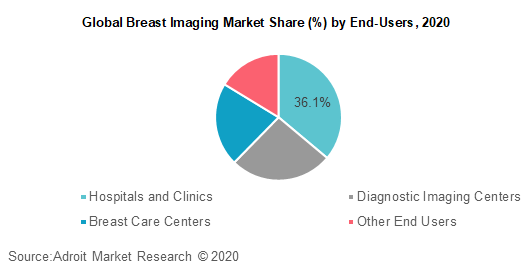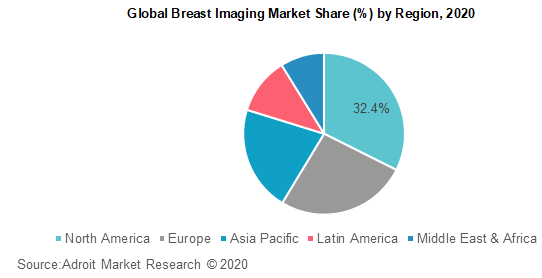At a compound annual growth rate of 7.1%, the size of the worldwide Breast Imaging market is projected to reach US$ 8.5 Billion in 2032.
.jpg)
The global breast imaging market was valued at USD 2,978.7 million in 2019 and is expected to grow at a CAGR of 7.9% over the forecast period. The global market growth is attributed to advancement in technology, rising breast cancer cases coupled with increasing screening procedures. The emerging economies particularly India, and China are projected to offer lucrative growth opportunities for the market players over the forecast period.
The global breast imaging market is categorized based on technology, and end-users. Region wise, North America was the largest market in 2019; however, Asia Pacific is expected to be the fastest growing region by 2028, with a CAGR of over 8%.
Key players serving the global breast imaging market include GE Healthcare, Siemens Healthcare, Hologic, Inc., Koninklijke Philips N.V., Fujifilm Holdings Corporation, CMR Naviscan, SonoCiné, AURORA HEALTHCARE US CORP, Dilon Medical Technologies, Inc., Carestream Health among other prominent players.
Breast Imaging Market Scope
| Metrics | Details |
| Base Year | 2023 |
| Historic Data | 2018-2022 |
| Forecast Period | 2024-2032 |
| Study Period | 2018-2032 |
| Forecast Unit | Value (USD) |
| Revenue forecast in 2032 | US$8.5 Billion |
| Growth Rate | CAGR of 7.1 % during 2022-2032 |
| Segment Covered | By Technology, By End User, Regions |
| Regions Covered | North America, Europe, Asia Pacific, South America, Middle East and Africa |
| Key Players Profiled | Siemens Healthcare GmbH, Seno Medical, Koninklijke Philips N.V., Fujifilm Holdings Corporation, Hologic, Inc., Aurora Imaging Technologies, Inc., Canon Inc., Dilon Technologies, Inc., Leica Biosystems Nussloch GmbH (Danaher), Carestream Health, Avante Health Solutions, Hitachi, Ltd, PLANMED OY, and Barco. |
Key Segment Of The Breast Imaging Market
By Technology (USD Billion)
• Ionizing Breast Imaging
• Mammography
• PET-CT
• MBI
• PEM
• CBC
• Non-ionizing
• Breast Imaging
• Breast Ultrasound
• Breast MRI
• AWBU
Breast thermography (USD Billion)
• Electric Impedance Tomography
• Optical Imaging
By End User (USD Billion)
• Hospitals & Clinics
• Diagnostic Imaging Centers
• Breast
• Care Centers
Regional Overview, (USD Billion)
North America
• US
• Canada
Europe
• Germany
• France
• UK
• Rest of Europe
Asia Pacific
• China
• India
• Japan
• Rest of Asia Pacific
South America
• Mexico
• Brazil
• Rest of South America
Middle East and South Africa
Frequently Asked Questions (FAQ) :
Breast cancer is projected to be the market's requirement catalyst. Breast cancer is the most common cancer observed in women in England according to a UNICEF report. Around 41,000 additional cases of women in England are infected with breast cancer worldwide. Consequently, Europe's demand for these products is expected to increase over the forecast period. Along with women, breast cancer often affects few people. Breast cancer, according to the National Cancer Federation (NBCF), is the second most prevalent form of cancer globally, responsible for around 10.9 per cent of cancer incidences among both men and women. The NBCF estimated that approximately 1,700 cases of male breast cancer are reported per year.
With rising lifestyle shifts and through the length of breastfeeding particularly in developing countries, the incidence of breast cancer disease is anticipated to increase. So, the market for such imaging devices is projected to increase over the forecast era.
Technological advancements such as molecular breast imaging, robotic mammography, optical imaging, electrical impedance imaging and tomosynthesis are now propelling the business, which are anticipated to witness profitable development over the projected era. Public initiatives such as awareness-raising campaigns and support for breast cancer research and growth are projected to improve the breast imaging market.
The global breast imaging market has been segmented based on technology and end users. Based on end users, the global breast imaging market is segmented into hospitals and clinics, diagnostic imaging centers, breast care centers, and other end users. In the year 2020, hospitals and clinics dominated the global breast imaging market with over 36.1% market share. The dominance is attributed to growing investments in advancement of healthcare facilities across emerging economies coupled with rising technological advancements across the medical device industry.

Based on technology, the global breast imaging market is segmented into ionizing technology, non-ionizing technology. These techniques can be divided according to frequency (from low to high: electromagnetic fields, infrared radiation, visible light and ultraviolet radiation) and to their general purpose (diagnostic or therapeutic). In diagnostic applications, a wide variety of new imaging modalities using non-ionizing radiation enables faster, cheaper and sometimes higher resolution anatomical imaging 'at the bedside'. Vital functions can increasingly be monitored from a distance. Flexible catheters make minimally invasive imaging and tissue ablation inside the body possible via small incisions in skin or gastrointestinal wall. The ever-smaller scale of surgical tools, tissue targeting using radiation-activated nanoparticles and miniaturized measurement devices may also help to make interventions more precise and potentially less demanding for the patient.
Based on regions, the global breast imaging market is segmented into North America, Europe, Asia Pacific, Central and South America and Middle East & Africa. North America currently holds the majority of the market share.

Asia Pacific breast imaging market is anticipated to witness highest growth rate owing to rising government policies for the betterment of healthcare facilities across the region. Furthermore, less developed economies as compared to China, India, and Japan are anticipated to witness low CAGR as compared to the developed economies. The burden of breast cancer remains high in low-income countries. For example, 5year survival rate is approximately 90% in developed countries, but this figure is reported to be around 60% in less developed nations in the Asia Pacific region1 and late stage at detection is a key contributory agent. Although multiple factors are linked to delayed diagnosis, advanced disease presentation suggests that diagnostic efficacy must be improved.

